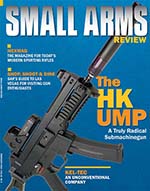Machine Gun Memorabilia: V22N2
By Robert G. Segel
Russian musicians horn banner “Fanfara” circa 1924 for Regimental Machine Gunners Commander’s Course. Used for all ceremonial purposes. Made of red velvet with gold braid fringe on three sides and applied linen images on each side. On one side is the Maxim machine gun within a wreath under a red Soviet star. The other side has a Lyre under a red Soviet star with two Russian letters “P” and two Russian letters “K” to the corners. The first Russian letter “P” (Polk) stands for Regiment. The second Russian letter “P” stands for Machine Gunners. The first Russian “K” stands for Commanders and the second Russian “K” stands for Course. The banner measures approximately 21½ x 24 inches not including the fringe.
Japanese sake cup commemorating the military service of a soldier in the 40th Infantry Regiment while in occupied China in the 1930s. Nicely detailed image of a Japanese Type 11 light machine gun among cherry blossoms. (Cherry blossoms are an important symbol in Japanese culture as the cherry blossom falls to its death at the height of its beauty.) Also shown is a 16 Joukyokujitsuki flag often referred to as the Japanese Navy flag but used by all branches of the military in World War II. The Japanese kanji denotes service in the Army’s 40th Infantry Regiment.
Irish Free State die stamped brass arm badge for machine gun marksmanship with the Vickers machine gun. Central image of two crossed Vickers machine guns applied to a rifle marksmanship badge with banner below reading “coisite.” Post-1922 era. Two lugs to the rear.
Trench art tea caddy. Brass and wood superbly made World War I trench art. The lower body is a large shell casing, which has been formed with three rings and has an applied Machine Gun Corps cap badge. There is an applied plaque that reads, “M.G.C. 107 Company Sergeants Mess Camiers 1917.” The initials “JD” are stamped on the back–presumably the maker’s. The wood base is approximately 5 inches in diameter. Atop the shell casing is a well-finished wood removable cap that fits smoothly and firmly. Affixed to the top is a finely detailed Vickers machine gun that can swivel 360 degrees. Beneath the gun is a very small General List uniform cuff button. Overall height is approximately 10 inches. During World War I, Camiers camp was the base depot of the Machine Gun Corps in France.
Latvian World War II era silver level light machine gun expert badge. Silver class (level II) pin back breast badge with silver hallmark on front and rear pin. Central image of a Lewis gun with wreath. Approximately 30mm.
1st Canadian Motor Machine Gun Brigade other ranks cap and collar badges. The cap and collar badges are made of browning copper. The cap badge has a left facing Colt Automatic Gun Model of 1895 “Potato Digger” machine gun. A left facing beaver sits atop a spoked wheel. The upper rim reads, “1st Motor Machine Gun,” and the bottom rim reads, “Brigade.” To each side is “19” and “14” (the year the unit was formed) with “Canada” in a banner beneath the gun. The collar badges are a matched pair with right and left facing beavers and right and left facing guns. The Brigade was organized on September 15, 1914, as “Sifton’s Battery” and was formed in Montreal from private funds. This Brigade had two batteries with 10 officers, 124 other ranks, 24 Colt machine guns, 8 armored cars, 8 trucks and 4 cars. The unit was disbanded on November 20, 1920.
German interwar tombstone-shaped (shoulder-strap style) “tinnie.” Issued on “Army Day” (Tag der Wehrmacht), March 19, 1939, by the 21st machine gun battalion for the “WHW” (Winter Relief Fund) with image at the top of a Maxim machine gun.
This article first appeared in Small Arms Review V22N2 (February 2018) |
| SUBSCRIBER COMMENT AREA |
Comments have not been generated for this article.










